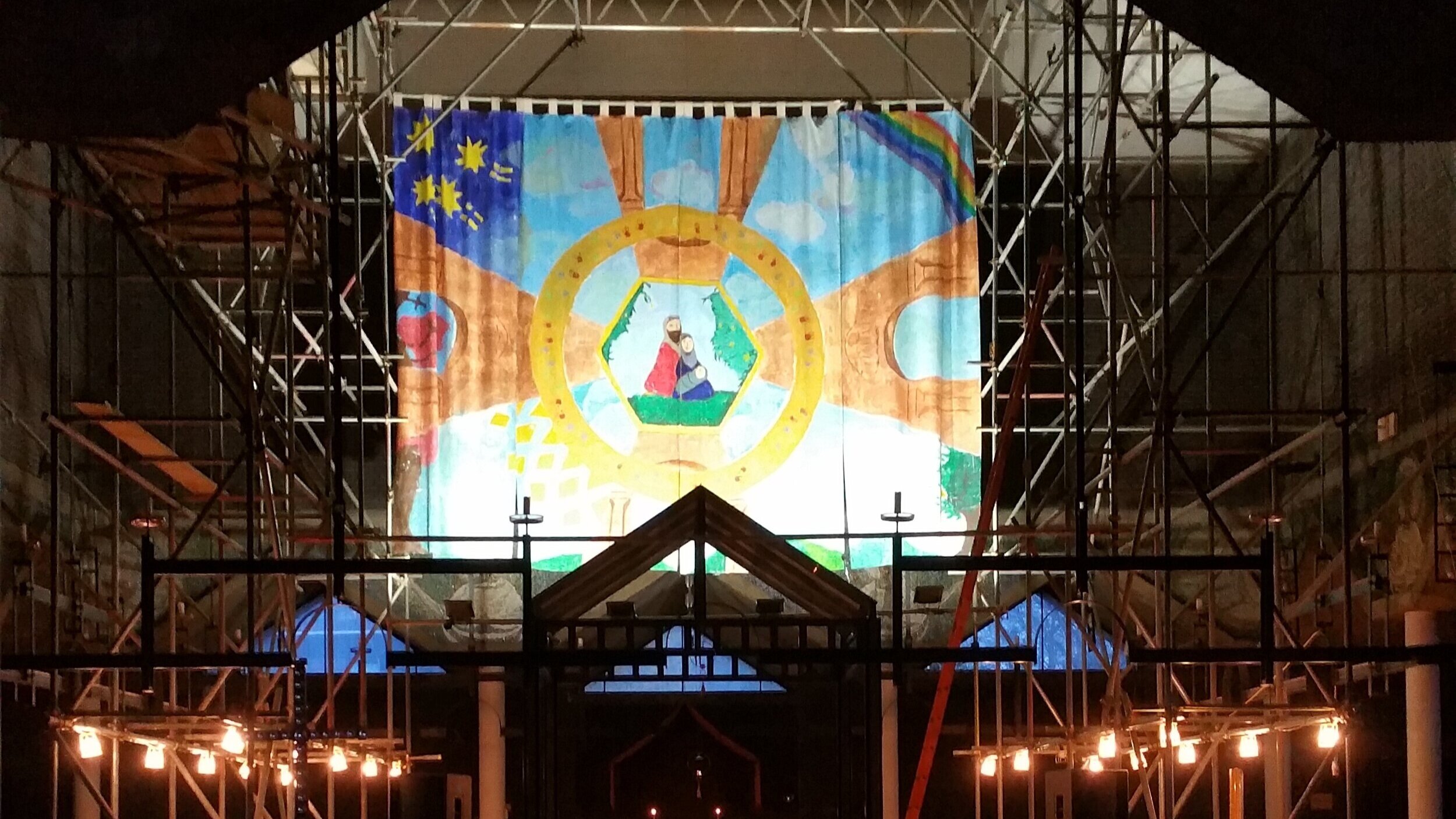
The art and culture of St Paul’s Bow Common
Artists and their works
From its reconstruction in the 50s, our Church has continually played host to an exciting, vibrant and unique community of artists and people from many creative disciplines. Some of the many highlights are detailed here.
Our dream is to continue our long-standing relationship with the artistic community in Tower Hamlets and beyond in the years to come.
The ‘Heavenly Host’ mosaic cycle by Charles Lutyens
The mosaics encircling the walls are the work of Charles Lutyens, great‐nephew of the architect Edwin Lutyens, carried out over a period of five years from 1963—68.
Charles reflected on how to represent the 'Heavenly Host'. In the Christian and Jewish tradition, angels have various functions and duties. Some act as Divine Messengers. Others surround the Divine Being with ceaseless worship and praise, these are the 'Heavenly Host' who were to be represented on the spandrels prepared above each of the pillars to receive them.
Charles visited the island of Murano in Venice, fabled for its production of mosaic tesserae and chose 700 colours as the palette from which he would work. He began in 1963 and during the next five years Charles worked on this huge expanse of 800 square feet, day by day, piece by piece, saying “I had placed each individual tessera with feeling and intuition, allowing the colours, as it were, to ‘call me.’”
Twelve angels make up the mural, and each corner represents an elemental creature for Earth, Air and Water and an abstract for Fire.
Lutyens completed his enormous work just as the funds ran out, but in his mind, the work still remained unfinished. And so, to express his dissatisfaction, he left a small patch of raw cement up in the south-west corner.
In 2011, after 43 years, and at the age of 78, he added the final missing piece; here was final closure on this work, with the second eye of the 'Earth Creature' being finally 'opened', now to look out upon the church and its ongoing life through the initials 'CL' (Charles Lutyens) which now form that eye of the Earth Creature.
Charles Lutyens, completing his mural cycle in 2011
The Mural by Charles Lutyens at St Paul’s, Bow Common
Photo: stevecadman, licensed under CC BY-NC-SA 2.0
Charles Lutyen’s mural in situ
Photo: _jjph, licensed under CC BY-NC-SA 2.0
Detail from the ‘Heavenly Host‘ cycle of murals
Architectural lettering & carving by Ralph Beyer
Ralph Beyer (1921—2008) was apprenticed to the sculptor and typeface designer Eric Gill and was also taught by sculptor Henry Moore. He is recognised for developing lettering from a craft tradition into an art form. His lettering work on Coventry Cathedral is said to be the most significant work of British public lettering of the 20th century.
The lintels of the entrance porch bear a statement from the Book of Genesis, ‘Truly this is none other, But the House of God, This is the Gate of Heaven.’
Beyer handcrafted each letter and imprinted each in the wet concrete. He also carved a large anchor into the sacrament altar, an early Christian symbol.
Ralph Beyer, lettering designer
‘Angel’ mural by Rose Finn‐Kelcey
‘Angel,’ was a temporary, site-specific installation by artist Rose Finn-Kelcey (1945—2014) which, in the first half of 2004, glittered and shimmered gloriously through 85,000 shimmer discs over the parish.
In 2007, the piece was judged the joint winner of the 2007/08 ACE Award for ‘Art in a Religious Context.
It was one of the largest works of public art in London at the time came, covering 850 sq. ft. of the exterior of the church’s upper section.
Read all about the shimmer disc mural Angel by Rose Finn-Kelcey in this detailed download (PDF 11.5 Mb)
Here is the short Case Study summarising the project (PDF 225Kb) and a recent case study published in 2019 by Art + Christianity.
‘Angel’, 2004 by Rose Finn-Kelcey
Art workshops
Twentieth Century Society & National Churches Trust
© Copyright Robert Drake & the Twentieth Century Society
Why is St Paul’s unique?
A charismatic priest wanting a new style of worship with centrally placed altar reflecting ‘the liturgical movement’ stemming from the Continent
Opportunity for experimentation in services when in congregations in the hall or temporary places with less Diocesan interference
Meeting of minds when Kirkby met Keith Murray (who had designed Royal Foundation of St Catherine chapel) and then Maguire
The revolutionary and austere design
What is so special about St Paul’s interior
First UK church to respond fully to liturgical reform agenda
Bringing congregation closer to and involving them in Eucharist – at the core of Kirkby’s approach
Influence of centrally planned Renaissance churches, the idea of harmony of man with nature
Also Thaxted church (Essex) – large areas of floor space and light flooding in
Diminishing cubes with ancillary spaces; 2 chapels, parish room, sacristy
Minimum of decoration: just red lettering and mosaics
A modern not a baroque Baldacchino at the centre
A processional route clearly demarcated
Challenges in getting it built
Distinguished but conservative architects on London DAC- Albert Richardson & Corfiato
Cost cut from £50k to £40k Maguire could then cut out extraneous detail as ‘cost cutting’
But possibly explains the use of wire wool and other inexpensive materials
Maguire used models – and model didn’t change much
New Churches Research Group founded 1957- enormous impetus towards acceptance of churches like St Paul’s by hierarchy
Post-war Architectural context
Liturgical movement coming from Germany
Ars sacra movement in France and pilgrimage church of le Corbusier especially Ronchamp – also a place of architectural pilgrimage. Kirkby visited these churches
New churches research group in UK- Peter Hammond wrote ‘Liturgy and Architecture’ St Paul’s architects Maguire and Murray were key players
Context of building St Paul’s Bow Common
The huge extent of destruction of churches in WWII bombing – 90 CofE churches destroyed
Equivalent numbers or other denominations
De-population post-1945
The pressure to pay for new churches in areas of population expansion (process started pre-war)
Meant in East End for 2-3 churches destroyed only one new one built
Attendees at the Twenthieth Century Society and NCT’s workshop
Ralph Beyer Lecture
Description to come here
Stitches in time
The creative workshop hosted by the local charity Stitches in Time drew a variety of people.
Some of those were directly involved with Stitches in Time, others came because they wanted to encourage their children in a creative activity, and others because of their belonging to the congregation of St Paul’s Church.
Once again, people gave a high rating to describe their experience. And all left feeling as though they had gained a useful skill or experience of heritage through participating in the event.
As with the partnership with the Twentieth Century Society, the church’s continuing link with Stitches in Time represents a deepening and enhancing of existing, rich, relationships.
Scaffolding banner art workshop
Our church school creative art project enabled local children to find out more about the architecture of the church as well as promoting the significance of the building.
Over two hundred people attended a special service which included a presentation about the building which has enabled local people to engage more effectively with the heritage of the space.
Original sketch for our enormous scaffolding banner
The scaffolding banner in all its glory
Detail of the scaffolding banner in position














